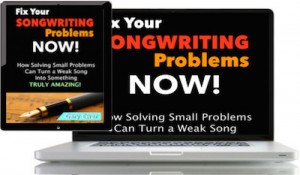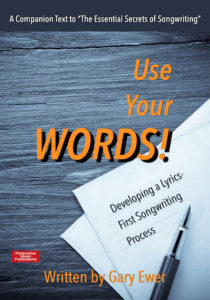You’ll hear experienced songwriters and producers say that the chorus of a song should arrive before the 1-minute mark. This is particularly true of songs with moderate to quicker tempos. Slower ballads can tolerate longer verses, and so it might take a bit longer.
That guideline is in place because producers like to ensure that the audience gets to hear the chorus hook without waiting a long time. Verses don’t often have as much sonic appeal as choruses do, and there’s always a danger that listeners will get bored or distracted before getting to the chorus.
 When you hear a problem with your song, but don’t know how to solve it, you might find the answer in “Fix Your Songwriting Problems – NOW!” Get this eBook separately, or as part of “The Essential Secrets of Songwriting 10-eBook Bundle”
When you hear a problem with your song, but don’t know how to solve it, you might find the answer in “Fix Your Songwriting Problems – NOW!” Get this eBook separately, or as part of “The Essential Secrets of Songwriting 10-eBook Bundle”
That’s true, of course, but there’s another related reason for recommending a chorus before the 1-minute mark, and it relates to musical energy, which typically ebbs and flows throughout a song.
A song is a journey which alternates between sections of low key intensity followed by sections of higher intensity. This is one typical design:

As you can see, a song’s overall energy (intensity, momentum, forward motion, even loudness, represented by the red arrow) increases as a song proceeds. Within each section, however, there is an ebb and flow, where energy intensifies, followed by a section where the energy diminishes.
Songwriters can use their writing technique to ensure that the energy is moving in the right direction by using melodies that sit higher or lower. And producers can manipulate intensity by increasing the loudness and energy of the musical accompaniment, and playing around with rhythms in the backing instrumentation.
So musical energy — and particularly the way it rises and falls — is as much responsible for getting to the chorus before the 1-minute mark than the simple need to hear the chorus hook. A long verse that exceeds 1 minute in length would keep the audience in that low-energy section too long.
Ballads are a different story, since we’re talking about relative section lengths. Because ballads are slower, all sections will usually be longer. So a longer verse is almost to be expected.
If you find that you’ve written a song where the verse seems a bit too long, one solution might be the obvious one: rewrite your verse to be shorter. But if as a stand-alone section, you like the way your verse sounds, you might try something else: a long, slow build in the accompanying instrumentation and production.
A great song demonstrating the art of the long, slow build that keeps the audience riveted is Bruce Springsteen’s “Thunder Road.” Masterful!
Written by Gary Ewer. Follow Gary on Twitter.

 Thousands of songwriters are using “The Essential Secrets of Songwriting 10-eBook Bundle” to polish their songwriting technique. Discover the secrets to writing great melodies, lyrics, chords, and more. And get a FREE copy of “Use Your Words! Developing a Lyrics-First Songwriting Process”
Thousands of songwriters are using “The Essential Secrets of Songwriting 10-eBook Bundle” to polish their songwriting technique. Discover the secrets to writing great melodies, lyrics, chords, and more. And get a FREE copy of “Use Your Words! Developing a Lyrics-First Songwriting Process”










